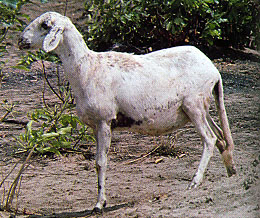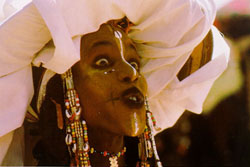CASE MNEMONIC: NIGER
CASE NAME: Desertification in Niger
CASE AUTHOR: Andrew H. Furber, June 1997

CASE NUMBER: 29
CASE MNEMONIC: NIGER
CASE NAME: Desertification in Niger
CASE AUTHOR: Andrew H. Furber, June 1997 
 I. CASE
BACKGROUND
I. CASE
BACKGROUND
Fights between nomads and sedentary peoples have occurred often in world history. In Niger alone, there are several diverse ethnic groups which live in three different climactic zones in Niger. The three zones are latitudinally divided according to the presence of the Sahara. The majority of the Northern part of the country is the Sahara desert. Ethnic groups there are primarily nomadic due to the ever-changing desert. South of the Sahara is a transition zone called the Sahel which is characterized by a combination of desert and less-desert like conditions. Nomads are also found in this area, although there are also many settled ethnic groups. The Sudan, south of the Sahel, offers arable land which is used to grow various crops, primarily for subsistence. Ethnic groups in this zone are diverse, consisting of old traditional sedentary communities integrated with formerly nomadic tribes.3

The Zarma are farmers who primarily live in the arid lands of the Sahel. Zarma is also spelled Djerma, or Dyerma, and are also called Zaberma. They live primarily in Western Niger, but there are also a few in Burkina Faso and Nigeria. They grow millet, sorghum, rice, corn and tobacco, and as cash crops, they raise cotton and peanuts. Since milk is an important part of their diet and culture, they also own cattle, but the Fulani or Tuareg people tend the animals. Cattle are driven to coastal cities of West Africa for trade to generate income. Zarma were once skilled on horses, which are also kept as a source of wealth. 9
Niger's agricultural policy is to achieve food self-sufficiency regardless of climate changes. The following means were recommended: dry-cropping in rural areas; hydro-agricultural projects including the use of depressions and water-points must be increased to increase cultivation; the "land Capital" must be more nationally exploited; soils must be improved by the introduction of phosphates, nitrogen based fertilizers and manure; traditional farming techniques must be replaced. Several efforts are being put forth to achieve self sufficiency. Projects to increase rain-fed crops on sand dunes are intended to increase millet and sorghum as well as cash crops mentioned above. Also, the government is making efforts to train individuals for the field to satisfy the need for agricultural specialists.

Despite frequent drought, animal husbandry is still one on the main economic activities of Niger. Herds are maintained in the Saharan and north Sahelian zones, but in the agricultural Sahelian areas, stock raising is a sedentarized activity. Livestock product include cattle sheep goats and dromedaries. The Fulani, also called Peul or Fulbe, are a primarily Muslim people found in many parts of West Africa, from Lake Chad to the Atlantic coast, with concentrations in Nigeria, Mali, Guinea, Cameroon, Senegal, and Niger. Given this dispersion of Fulani groups, the Fulani interact with each other as herders and farmers. The typical Fulani are nomads, but after many years of integration with other cultures, and the depletion of their herds to environmental conditions, they rely on farming for livelihood. The nomads make temporary camps of portable huts, exchanging dairy produce for cereal foods; cattle are rarely killed for meat.
The pulse model is used by archeologists to describe the tendency of the Sahara desert to "move" South and back in waves over thousands of years, having socio-economic impacts on the peoples living in its path. Archeologists working in the Middle Niger region of West Africa have come across evidence of social clusters of communities that are grouped around Timbuktu, but were not an integrated community. Roderick McIntosh argues that each group established its own identity and culture, accommodating to the other groups over time, and having economic specialization. The archaeological findings combined with geological dating techniques suggest a "pulse" pattern of Sahara desertification. Every time a pulse period is experienced, settled societies are uprooted and forced to move. Studies show pulses beginning 10,000 years ago. McIntosh's study partly establishes that the desert oscillations correspond to apparent changes in the archeological findings that indicate changes in societal identity of Late Stone Age people. Research indicates that the longer a community stays in one place, the more sedentary it becomes, the more traditions it develops and the more highly specialized social clusters become. So when it is forced to move, these traditions are upset or lost and specialization diminishes. He suggests that like today, receding amounts of open water mean smaller "microenvironments" and greater contact between people seeking the same resource. The increased contact should result in increased conflict. However, unlike today, since clusters would specialize in certain trades or services, they developed a sense of "corporate identity" which discouraged inter-group conflict.8
The pulse model partially explains why conflict might increase when applied to today's desertification conditions. The corporate identity established by specialized groups through years of sedentarism is being disturbed by the process of desertification. Movement of the desert southwards is forcing tribes to relocate, and this is indirectly causing conflict. If one were to hypothesize about what started this whole process, the pulse models absolves responsibility of any human being. On the other hand, French colonization of Niger in the 1920's increased grazing intensity and cash crop agriculture in the Sahel. Change in the use of the environment effectively initiated a socio-economic correlation between human impact and desertification.
Continent: Africa
Region: West Africa
Country: Niger
 II. Environment
Aspects
II. Environment
AspectsA comprehensive expression of economic and social processes as well as those natural and induced ones which destroy the equilibrium of soil, vegetation, air and water, in the areas subject to edaphic and/or climatic aridity. Continued deterioration leads to a decrease in, or destruction of the biological potential of the land, deterioration of living conditions and an increase of desert landscape.4
 11
11Definitions of desertification like the one above show "adverse human impact" as its primary cause. Overgrazing natural barriers is the primary cause of desertification. The Eden Foundation has demonstrated the advantages of re-planting such areas in its effort to prevent desertification. Desertification is a cycle of destroying barriers, encroaching desert, re-location, and more destruction. Arable land for agriculture is overtaken by the desert and state policies to restrict stock mean less food. The dilemma is exemplified in Niger today, when farmers and herders coexist with limited resources. The Pulse model described below adds to the seasonal fluctuations in rainfall, soil quality and crop yield.5 Migrations correspond to fluctuations in rainfall. Studies of desertification are challenged by differences in populations of people and herds due to the changes of seasons.6 For information about remote sensing of the desertification process, refer to Intellectual Property Rights in Space, and Remote Sensing Issues.
In response to the diminishing opportunities for herders, some are relocating, others are settling; either in towns or as farmers. Given the susceptibility to change a nomad is faced with, s/he is also able to work in different jobs. This was the case of herders whose stock was lost to drought.7
Act Site Harm Site Example Niger Niger Desertification and Conflict
 III. Conflict
Aspects
III. Conflict
AspectsEthnic Violence Leaves Seven Dead
Seven people were killed and 43 wounded last Sunday and Monday in separate clashes between Fulani herders and Zarma farmers in the arrondissements of Téra and Birni N'Gaouré. La Voix du Sahel (state radio) reported Tuesday that all seven deaths occurred Monday evening near the village of Falmaye (Birni N'Gaouré), 90 km southeast of Niamey. According to the broadcast, Zarma villagers attacked a Fulani camp, seeking revenge for the death of a Zarma in a fight with Fulani herders earlier in the day. At least three of the victims were burned to death inside their straw huts. Three people have been arrested and security forces in the area have been strengthened. On Sunday, there had been fighting between Fulani herders and Zarma farmers in the Téra region, 160 km northwest of Niamey. There were no deaths, but 35 people were wounded, 19 seriously.2
 III. Environment and Conflict Overlap
III. Environment and Conflict OverlapThe state also plays a role in the desertification process. It is in the state's best interest to preserve itself. It must take measures against the desert to prevent indirect loss of possible tax income from herders who loose their stock and farmers who loose their crops. State policies encourage animal husbandry, subsistence farming and support ethnic groups which are involved with these activities. 12
 IV. Related
Information and Sources
IV. Related
Information and Sources
ICE Cases
ANGOLA Case
SAHARA Case
NILE Case
ERITREA Case
JORDAN Case
KUWAIT Case
LITANI Case
IRNUKE Case
